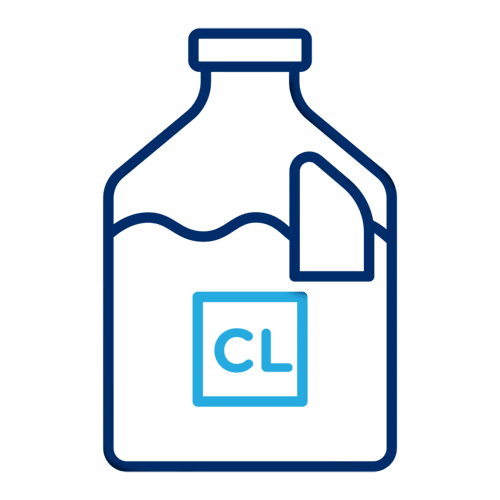
In the realm of pool maintenance, the debate between using chlorine shock or non-chlorine shock has been a hot topic for quite some time now. While both have the same job, there are notable differences between the two. As you wade through the options, weighing the pros and cons, the big question is, “which shock treatment takes the crown for giving you the perfect pool water?”
Let’s dive into the nitty-gritty of chlorine versus non-chlorine shock and answer this ever-so-popular question.
Non-Chlorine Shock
Chlorine-Free shock treatments usually have Oxy in the name, because they contain oxygen, with salts of potassium. Some call this type of shock MPS, short for monopersulfate, which is short for the longer name potassium peroxymonopersulfate. Chlorine-free shock has its advantages, and also disadvantages, when compared to the 3 types of chlorine-based pool shock that is normally available.
Pros:

- Quick release, fast acting, no residue, no odor
- pH balanced, no effect on pH
- Oxidizes organic contaminants to purify water
- Removes chloramines and ammonia
- No pre-dissolving needed, pour into pool
- Can swim immediately, no waiting period
- Won’t bleach or fade vinyl liners or swimsuits
- Won’t add calcium or cyanuric acid to the pool
Cons:
- Costs about 10% more than chlorine shock
- Not very effective for algae treatment
- Not very effective for bacteria treatment
Best Uses:
- Chloramine removal: Chlorine-free shock can be used effectively to break apart combined chlorine molecules, and restore a foul-smelling, red-eye pool back to normal, without super-dosing on chlorine. Interestingly, however, non-chlorine shock will interfere with the Total Chlorine DPD #3 reagent, making it appear like there are chloramines, when there are not. A De-Ox reagent can be added to remove the interference of MPS on pools using non-chlorine shock.
- Contaminant removal: Non-chlorine shock does a great job of attacking the daily onslaught of natural and organic contaminants that end up in your pool. Dust, dirt, leaves, bird droppings, insects, grass clippings – and body oils and swimmer waste too. Helps your chlorine and your pool filter by removing most of the solids and particles (seen and unseen) from the water, to make sanitation and filtration more efficient.
Chlorine Shock
Chlorine shock treatments come in three types: Cal Hypo, Lithium Hypo and Dichlor. Calcium Hypochlorite (Cal Hypo) is the most common type of chlorine pool shock and the cheapest, available in two strengths, regular and super. Lithium hypochlorite contains no calcium and dissolves instantly, but is less powerful (and more costly) than Cal Hypo. Dichlor is a stabilized granular pool shock, made with cyanuric acid to protect it from the sun and keep it active longer.
Pros:

- Quick release, fast acting
- Oxidizes organic contaminants to purify water
- Removes chloramines and ammonia
- Kills algae and bacteria easily to disinfect water
- Cheapest way to shock the pool (Cal Hypo)
Cons:
- Pre-dissolving granular is recommended for surface protection
- Waiting period of 12-24 hours is generally recommended
- High levels of chlorine can be harsh on soft and shiny surfaces
- Cal Hypo adds calcium, and Dichlor adds cyanuric acid (a ‘Pro’ in some cases)
- Higher pH levels, except for Dichlor (a ‘Pro’ in some cases)
- Generally more hazardous to store and use, and with strong odor
- Residue of ‘shock dust’ is often left, or water becomes cloudy
Best Uses:
In addition to performing the contaminant and chloramine removal job that chlorine-free shock can do (discussed above), chlorine shock goes beyond, for control and removal of all types of algae and bacteria.
- Algae removal: Chlorine shock stands tall in the face of severe algae blooms. Non-chlorine shock will have some effect on small localized blooms, but for a green pool, add enough chlorine pool shock to reach 30 ppm (with a suitably low pH level and balanced alkalinity and calcium levels), and the algae will suddenly succumb. Granular pool shock is the best treatment for pool algae.
- Bacteria removal: Granular chlorine penetrates deep into cellular membranes, to the nucleus of the cell, completely destroying it from the inside out. Non-chlorine shock will destroy your basic bacteria, but for the stronger varieties, it just can’t get past their defensive walls. For control of pathogenic bacteria, those that can make you sick, a shock treatment with chlorine will neutralize 100% of germs to sanitize and disinfect the water.
So, Which is Better?
It used to be that there was a big difference in price, with non-chlorine shock being much more costly, but now they are nearly equal in price.
Non-chlorine shock has a lot of advantages, and could be used as the primary oxidizer for a pool or spa, saving use of chlorine shock for instances like pool opening, algae blooms or high bather load (lots of swimmers or hot tubbers). For general contaminant and chloramine removal, which helps your overall sanitation and filtration, why not give non-chlorine shock a try – it’s gentler with far fewer side effects.
Overall, we recommend using both types! Use a non-chlorine shock for general oxidation, and use a chlorine shock for those less frequent occasions listed above, where the power of chlorine is really needed.



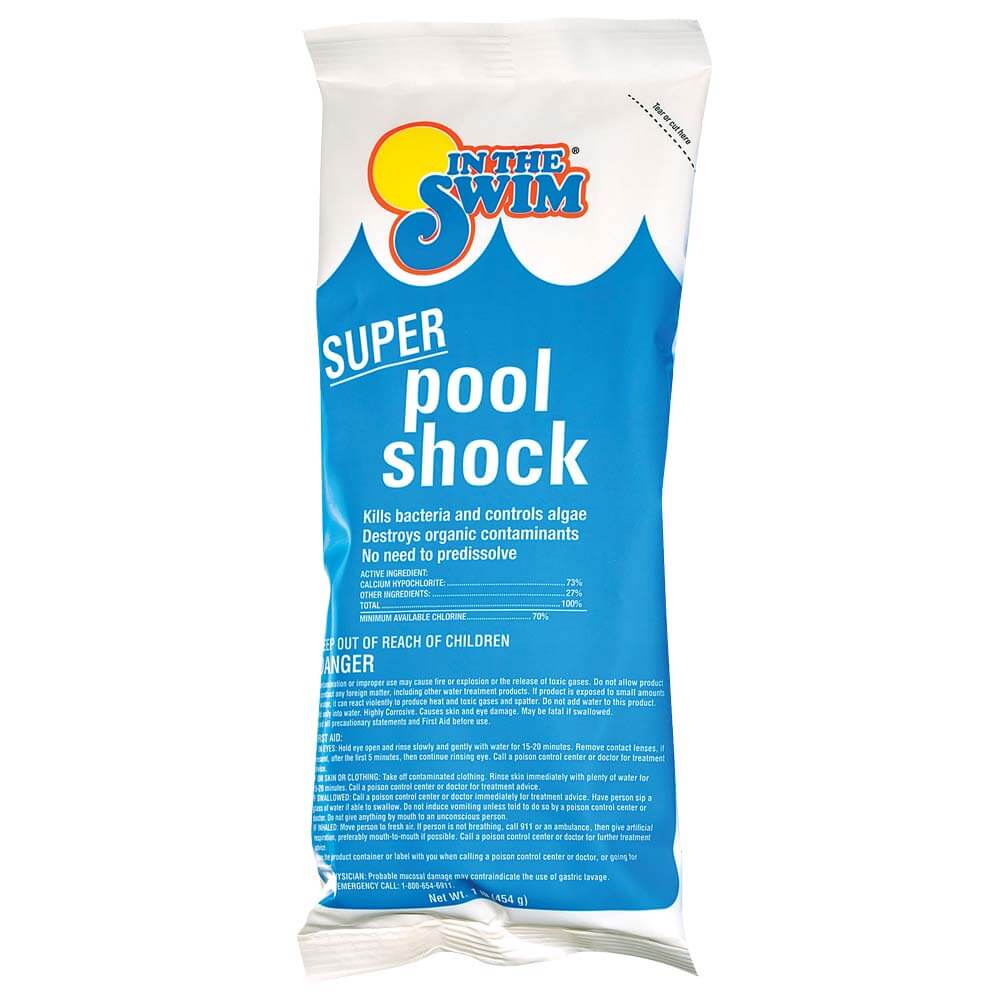
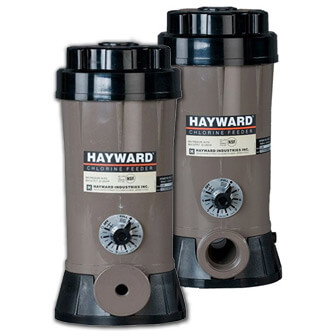
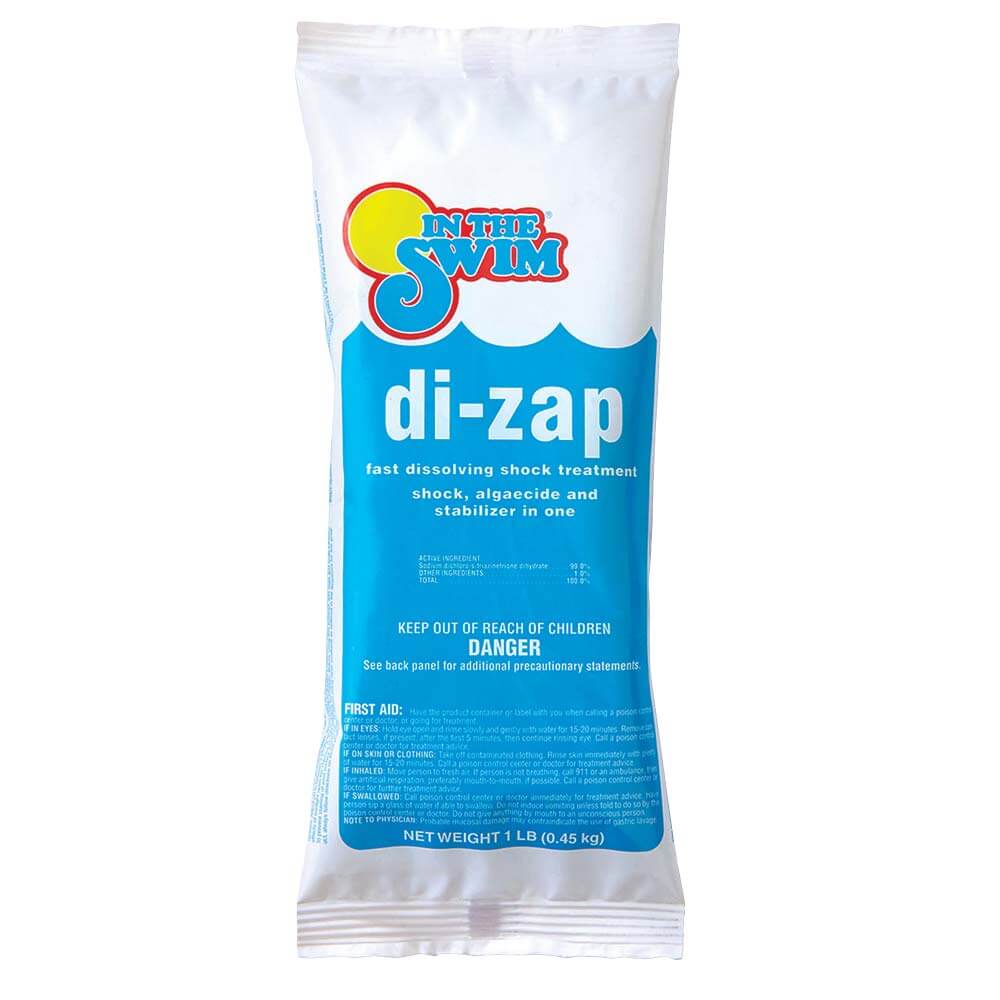
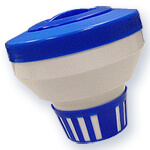



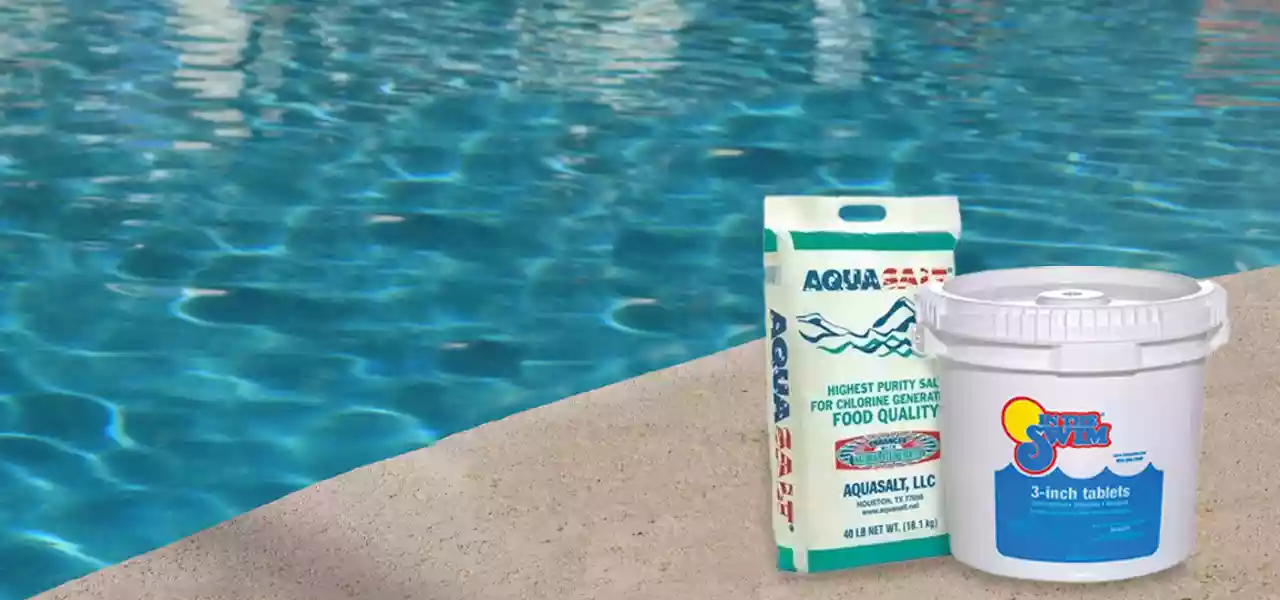
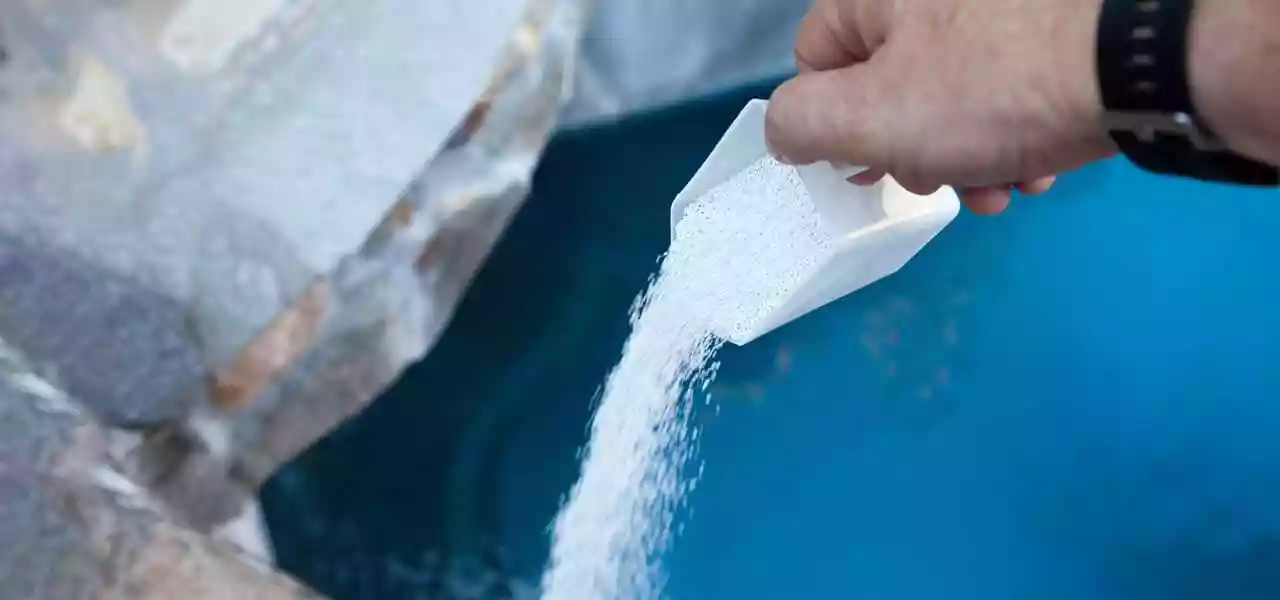
Hi:
Recently I was told the only way I’m permitted to drain any water out of my 12,000 gallon above ground pool is on my own property. I drain the entire pool every couple of years.
1) Will chlorine free shock kill the grass?
2) What is the best de-chlorinator to use so I won’t kill the grass.
Hi Harlan, chlorine levels of up to 3 ppm won’t damage the lawn. It does not need to be zero chlorine, just not high levels.
What about chlorine free shock? Will that have any affect on my lawn?
No, I don’t think so – but then again I would not shock the pool and then immediately start pumping it out. If you wait at least 24 hours after shocking with non-chlorine, you should be ok
I have no chlorine free and low chlorine. Pool balanced. They said I had nitrates. Told me to super shock with with one 2gallon jugs of chlorine and 3 1 lb. bags. And my auto pilot running at 100%. Still had nitrates. So they said to super shock again so we did two 2 gallon jugs and turned the auto polit to 100%. Still have nitrates but getting better I think. Should we super shock again?
Hi Diane, yes, assuming your pH level is nice and low, 7.2-7.4. And if you still have no chlorine level after all that super shock, then super-super shock with a larger dose, to reach a breakpoint threshold. Previous shocks may have missed the mark if you still can’t get a chlorine reading.
Hi there. Our chlorine readings have been almost 0 for the last few weeks. We did have an algae bloom, but even after getting it under control, the chlorine level just won’t raise. We’ve added up to 9 bags of shock at once & nothing. Any suggestions as to what is causing this or how to fix it? (The levels of the other chemicals seem to be ok)
HI Latia, sometimes it is a high level of ammonia or nitrates in the water, which is consuming the chlorine, but a 9 lb shocking will typically clear that up… in other cases, the level of cyanuric acid is zero, or over 100 ppm. It could also be bad test reagents. Could be a high level of phosphates, or a high level of chloramines, aka combined chlorine, which also is usually fixed with a 9 lbs shocking.
Hi I’m trying to de algae a pool. Can you use chlorine shock at the same time as non chlorine shock to hit the algae hard!
Yes, you could do that, adding them separately of course. CHlorine shock is more effective on algae than non-chlorine shock, but both will help!
I have a total chlorine level at about 10 after shocking my pool with chlorine shock. The free chlorine is at 4. Should I add some non chlorine shock to bring down total chlorine or will it burn off on its own? Trying to get swimmers in it asap. Thank you
I would test again to confirm, but when total chlorine is greater than free chlorine, the difference is combined chlorine. 6 ppm of combined (aka chloramines) is very, very high! You would want to shock the pool to about 25 ppm, to break apart the bonds and restore order, to where total and free are equal. Even a difference of 0.3 ppm is generally agreed upon to be high enough to warrant a good shock treatment, to burn off the combined chlorine and byproducts of chlorination.
I am adding a non-chlorine shock to a 3000 gallon pool before we leave for an 8 day vacation. Should I also add a double dose of chlorine, any algaecide, and should I cover it or not?
Hi Craig, yes to the shock and double chlorine, and algaecide and cover, yes to all that! Have a great vacation! Don’t shut the pump off! Put it on a plug-in timer.
Hi, I test my pool water often (with strips and at a professional pool dealer store). This is my second season with my inground, saltwater pool. I have always had a perfect stabilizer / cyanuric acid reading of between 30 and 50. About 3 weeks ago I had some chlorine lock. The pool store professional advised me to add chlorinated and non-chlorinated shock at the same time to unlock the chlorine. Ever since then I have had a high stabilizer reading. It is registering at 85-100 now. This upsets me. I called the manufacturer of my salt cell system and they say the ideal reading for my salt cell is 40. What do I do? I have looked online at cyanuric acid lowering agents and they all get terrible ratings.
Hi Catherine, the cyanuric reducers, seem to work for slightly more than half the people. First, I would have the cyanuric re-tested, just to be sure, sometimes test results are wrong. Then if it was that high, I would either drain half the pool and refill (and add more salt), or try one of the reducers, maybe you’ll get lucky? 🙂 Cyanuric levels of 100 ppm and higher can be problematic, but not always.
Hello,
Is it safe to use Chlorine shock and Non Chlorine shock in the same day?
Sure, no problem Sharon.
I am this bind at the moment. I just used 5 pounds of Cal-hypo in a 9,000 gallon pool and did not break the chlorine lock. I am now prepared to try non-chlor shock. However, question: If my free chlorine is still higher than combined chlorine, is it okay? Many thanks.
Hi Paul, would it be hard to drain the pool, or drain half and refill? For a pool so small, that comes to mind quickly for me! Esp. if you have not changed water recently, over time it becomes choked with solids and other gunk, and fresh water is so much more easily managed. And cheaper than chemicals, in most cases.
Thanks very much, Dave. This has recently struck me as an option based on research (my pool people have not been very well informed). I should have done this before the weather got hot! I’m grateful.
I read that a non-chlorine shock is needed to break “chlorine lock”. We might have this situation as no amount of shock or chlorine added to our pool will give a free chlorine reading on test strip. The total chlorine is high. Would you agree with the assessment of this situation? We usually have no trouble opening our pool in the spring but this year, for the first time, we have tons of algae.
Hi Joan, I am familiar with the chlorine lock phenomenon, however I have always used chlorine to ‘break-thru’- usually using 3-5 lbs of shock per 10,000 gallons. I suppose that you could use non-chlorine shock as well. If you still have green water however, go with chlorine, and keep adding until it turns blue.
Does non-chlorine oxidizers bring up the orp in pools
Hi Garrett, yes it is my understanding that non-chlorine shock will raise ORP readings, even though they are not actually a disinfectant.
When you say ORP are you talking about oxygen Redox Potentials
Yes, actually “Oxygen Reduction Potential”